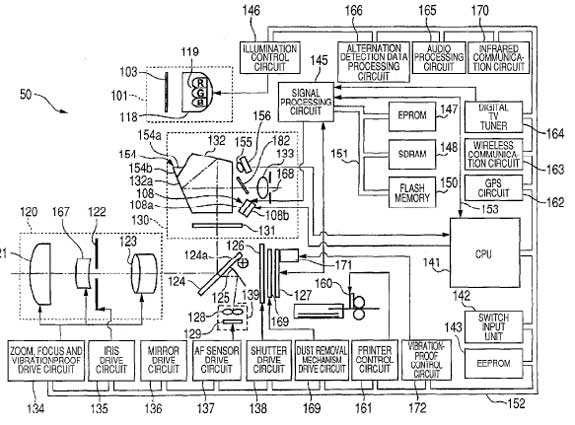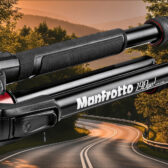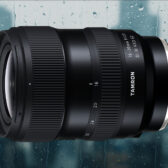Patent Fun
I like to lead with the following, I am the worst reader of patent language on planet earth.
I’ve been sent an email explaining this patent.
“The image pickup element vibrationproof circuit 172 cancels vibration of an image by moving the image pickup element 127” and “Here, an image pickup element vibrationproof mechanism 171 connected to the image pickup element vibrationproof circuit 172 shifts and rotates the image pickup element 127 in the direction to cancel shakes of the image so as to prevent the resolution of the image from being lost as the image rolls.”
Is this in body stabilization that works together with in lens stabilization? The language of it seems to suggest so to me.
Also notice the GPS circuit, Digital TV Tuner and Wireless Communication Circuit.
What say you?
Read The Full Patent: http://www.freepatentsonline.com/20100103305.pdf
thanks sean
cr
|
When you purchase through links on our site, we may earn an affiliate commission. Here's how it works. |










It defies me that you post up this stuff yet ignore completely valid rumors such as this.
http://www.canonrumors.com/2010/04/new-lenses-2/comment-page-1/#comment-51407
I notice the camera still has a “printer control circuit”. WOOHOO!
Lolw00t?
Sounds like it may be an IS but I have no idea.
Lol what the..?
You calim to know something out of nowhere and complain about CR guy not mentioning it?
You’re not serious, right?
I think I will comment 4 times that the 60D is going to get GPS and then complain that CR guy doesn’t make a news even though I sayd it some times!!
-.-
What the 0_0 do you also see the GPS circuit?
Is this the 60D?
There is no camera with GPS yet, right?
I still see there’s a “Printer Control Circuit”, so those worried that Direct Print functionality was to be removed can rest easy.
DIGITAL TV TUNER CIRCUIT – 164
Watch your favorite shows while on the move or while waiting for that perfect shot with the new in built tv tuner available in all new canon bodies Q2 2010
Heard it here first people
60D is going to get GPS
Looking at the diagram I think this may be a sandwich toaster of some kind, probably aimed at the cheese + tomato market but may also do other fillings.
I’m just saying this so obviously complete trash yet other liek you and me make constructive comments.
Samsung’s CL-65 is a point-and-shoot camera AND has a built-in GPS. I really don’t k now about other cameras… and it’s about time to DSLRs have it!
Exactly what I was going to mention. While in-body stabilization is great, its not a new feature in the sense that your camera can already be stabilized. Built-in GPS, however… that’s awesome.
This is definitely a DSLR based on the above diagram, not an EVIL camera. Can’t wait for something else to surface. :)
In body IS will arrive in the next generation bodies for 2 reasons ;
1. Nikon do it
2. Videographers like using primes and IS would be another big plus to DSLR video for handheld and steadycam work.
I’m more captivated by the Iris Control Circuit …
Ah woops. Judging by its location it looks like it controls the aperture thingie.
aperture
Even though there is only one “Printer Control Circuit”, I think there is still hope for two direct print buttons.
I haven’t yet read the comments on that thread.
I have previously been sent bad photoshop EF-S f/4 lens mockups, I’m waiting for something substantiated.
Thanks!
cr
TV Tuner? This has got to be a joke.
but is it a rumor ?
or is a canon patent?
I read through much of the fine print. Looks like there will be some type of Picture in Picture in the viewfinder so that you will be able to see what you last shot while still focusing on the subject. All without removing your eye from the viewfinder. That’s pretty cool stuff if true!!
Note that the name of the Patent is “Image Capture Apparatus with Optical Finder”
Start by reading the last 2 pages of the patent!
this patent is for a cam like the G11
the lens is not exchangeable
I was talking about canon dslr
I highly doubt that IS in the body will work in synchronous with the IS in a lens, unless both IS systems are designed to work together (in which they are not!)
Even if, say, the IS system in the lens sends its information to the body, it will be very difficult for the IS in the body to move just to keep track of the movement of the IS in the lens, let alone helping to get more stops in the stabilization purpose.
What I think is that, if Canon releases a body that has stabilizer, it will work with any lens. However, you must turn one of the IS systems off if you use it with an IS lens. Since it is likely that the IS in the body will not be as effective, i.e. less stops gained than the one in the lens. So, it will be preferable to turn the IS in the body off.
Does a G11 type camera have a PentaPrism or a dust cleaning system? I haven’t checked but I highly doubt it.
says….?
says……?
This is completely not true. Dust removal & mirror in a camera with no interchangeable lens? Makes no sense. The figure is that of a DSLR.
But really, the big question: A camera that you can use to watch TV? I guess its useful if they want to do a product that is certain NOT to appeal to serious amateurs (or to serious humans in general).
At least it would be more useful than a direct-print button…
The big news is that Canon is contemplating an advanced use of an electronic viewfinder in an SLR.
I read through the patent application and the claim to fame is the viewfinder. The patent claims that the novelty is the ability to display an optical image and an electronic image at the same time. But the reason for this wording is that several other patents already exists for combined optical/electrical viewfinders.
Since the application is for a complete camera system the indicated in body image stabilization system may or may not be significant. It is however not the focus of attention.
A footnote: The dust protection obviously means that the lenses are interchangeable, but the lens diagram has no provision for lens image stabilization. It does however have a “zoom and focus control”. What kind of lens are we looking at here?
Maybe it would have 4 modes selectable by custom function (0 default)–
0 — IS in body on, but dampened if IS on in lens is detected
1 — IS in body on, but deactivates if IS on in lens is detected
2 — IS in body on all the time
3 — IS in body off
excellent. now while doing long exposures at night i can watch tv!
this in body is will probably show up on the 60d….
I think it’s probably for TV output rather than receiving TV stations
From the diagram only looks like the Prism is a modular unit, just like the flash and the Lens. The flash looks like it could be and LED flash with RGB LED’s in it. Again I’m just going on the diagram here.
And from the looks of it, it could be a total system on a chip controller for a future Digic processor perhaps??
he met to say canon dslrs
or live histogram in the viewfinder
Nikon do it? Do they??
Me wants the 60D Image Capture Apparatus. With Optical Finder.
I still can’t understand how in-body IS could work together with in-lens IS? Surely the IBIS would only be activated if the ILIS is not there/switched off. Otherwise, you’d be moving the sensor in relation to a stabilized image and get all the nice camera shake back into your photo!
I think I do understand the patent:
The camera offers to use the viewfinder even for video mode !!!
There is an electronic viewfinder within the optical pentaprism-viewfinder. This allows to display video in the viewfinder even if the mirror is up.
The most logical explanation for the rgb unit above the vf is an electronic viewfinder.
This is not possible because there is no way to capture the live histogram -> the mirror is down.
Even better:
Using the hybrid (optical/electronic) viewfinder in video mode when the mirror is up.
Or is it just a misplaced, normal screen?
New rumors for the 60D :-)
– 18MP
– Electronic Viewfinder for Video-Mode (something that is not available in the current lineup and excellent for the targeted prosumer market)
Actually, if you read the patent, it’s a mockup of an RGB LED flash unit, also controllable by UWB wirelessly (including color temperature).
Canon are either letting slip a number of soon-to-be technologies (finally learning good press?), or are posturing to make Sony / Nikon / Pentax / etc. nervous. As a lot of these are features which we all know to be inevitable, though, it’s certainly interesting conversation :).
Nikon have a patent application in for it (in a DSLR / EVIL / interchangeable lens body), but to my knowledge have not shipped a product so equipped.
Not. see the arrow. Digital TV Tuner delivery signal to Signal Processing Circuit. Then, it’s a … tv tuner. ?????????????? is there a minigame? tetris ? calculator is good. multi touth? unit converter? windows LOOL.
(i dont speak english, sorry)
That said, after a second read through, the ‘TV tuner’ function is actually for an EVF which will allow you to ‘chimp’ from inside the viewfinder, allowing you to continue shooting while actively reviewing your shots.
As such, we might infer that the ‘tuner’ reference is actually an artifact of poor translation (more likely), or is because the feature is one which has been rather ‘hacked’ into the system as a priority add on feature (less likely, but plausible given the value it would have for LiveView – *video* – shooting).
And fwiw, I think the mockup is actually the 1DsIV, though I expect the 60D will have at least one of the features.
what the hell, who said ANYTHING about watching TV?!
This makes an awful lot of sense – that and the typical XXD framerate make it a step up from the T2i, while keeping the current AF system which doesn’t allow it to intrude on the 7D’s market share.
Then a 1DsIV with all the bells and whistles from the patent app, announced for Photokina alongside a new LED flash system w/ RF control and the 24-70 IS – expect handheld landscape / cityscape photos to be shown, shot at dusk, at low ISO. Then samples of super high ISO which will be equally impressive (with consideration for sensel size). 32 MP Bayer, ISO to 12800 or 25600, 5 or 6 fps, 1DIV AF, GPS, EVF, sensor IS, and UWB flash control.
Fast forward a year and see 5DIII with 21MP sensor (with upgraded sensor coatings, LPF, and Bayer filter) for a 1-2 stop noise improvement, in-body IS, 18pt x-type AF, EVF, GPS (if cost is low enough), and 5 fps.
Another 6 months for the 7DII @ 18MP, EVF, GPS, IS, still 8 fps, new on-sensor AF system (maybe debuting on 5DIII), and 1-2 stop noise improvement. First Rebel FF debuts here as well; probably with the 5D3 sensor.
At least, it sounds good to me :P.
I think the lens IS is described by “vibrationproof”. Probably 167 in the diagram.
“shifts and rotates the image pickup element” … “as the image rolls”
An in-body IS would make sense to cancel the roll motion.
Apart from the electronic VF for Video, there are other very intersting details in this patent:
– An organic display that indicates the AF point superimposed to the focusing screen.
– An automatic brightness adjustment for the electronic
viewfinder
great vision…let’s go for it
I also find the “zoom, focus, and vibrationproof drive circuit”
interesting, sounds like canon may build a lens with power zoom for video.
My theory is this…
TV Tuner circuit is simple. video out req. tv tuner circuit to go straight to tv chnl 3/4.
gps circuit is fairly simple. Folks been screaming for a goetagging option for a good while now. they’re just finally getting off the bench on it.
and as far as dual IS…
I think that dual IS probably represents more of a technical hurdle than would commonly be thought. My guess is that it has some sort of sensing system to identify if a lens has the IS feature, and if present, disables the in-camera vibration control unit. I would imagine they would ONLY offer this on the EF-S mount cameras because it might bite into their EF lens sales too much.
Just my musings on it.
But… it also has a built-in Printer (160), so the direct print button has a use.
For the many people that are hoping that this is all going to show up on the 60D. I doubt something that was just patented will likely show up in a product right away. I assume there needs to be changes in manufacturing processes to happen for production to happen. I’m not one that gets rumors sent to me nor do I read all of them. Considering Canon produces some of the most patents of most companies, I doubt all get used and often get shelved away for years. I’m not holding my breath.
There have been so many comments and such that the 60D, if it will exist, will be announced in a few months and available by next year. I don’t know. I want one too and I hope I’m proven wrong.
I’m sure others will have an opinion on this (hopefully a more expert one – hopefully those in manufacturing project management/engineering), so feel free to cut up my comment… lol.
since the patent specifically says “digital single Lens reflex camera, I think you did not read it.
Creative imagination you have there.
A dual IS makes perfectly sense if they handle different stabilisation tasks.
A lens IS can never correct for camera rotation about the optical axis. This is because the lens is rotationally symmetric around the optical axis.
A image sensor IS can do both Shift and Rotation.
So I would implement the shift compensation in the lens and the rotational compensation in the focal plane.
I am missing the mirror-lock-up circuit. ;-)
From what i can see, this is a new patent which is updated to offer different solutions to problems existing in a older patent.
It covers multiple configurations which are quite different. The possible configurations have the same basic optical and simultaneous liveview feature,
It is for a digital single lens Reflex camera.
The lens has Internal IS, but it does not specifically say if the lens is removable, at least, I did not see it.
The Sensor is also image stabilized.
It allows the viewfinder to be switched between optical view and live view.
Some of the other features:
Infrared communication (low rate)
Wireless communication (apparently wi-fi)
GPS
Built-in TV
Built-in Printer
Speakers and microphone
Configuration 1 has a conventional flip-up mirror and phase detect autofocus, its a still camera only. The image that has just been taken will display for a short time in the viewfinder, much as it currently does on the rear lcd. If you half depress the shutter button, it will instantly revert to a optical finder and show the current scene. This will let you immediately see the image composition, and lighting of the image you just captured so that, if it is bad in some way, you can make any adjustments necessary and then try to capture a correct image.
Configuration 2 is a PARTIAL digital single lens reflex camera that has a fixed pellicle mirror and phase detect autofocus with video or still capability. This is basically a semi-evil camera, but has both optical and EVF in the same viewfinder.
The 3rd configuration is a mirrorless INFRARED CAMERA, and uses a prism to split the light and send visible to the optical finder, and infrared to the sensor.
The forth configuration is the same as configuration one, except it contains the ability to show your position on a map using GPS and a wireless connection to the internet. Also seen in the viewfinder.
The fifth configuration is The same as the first configuration, except it communicates with another camera and will let you view images from the other camera with the idea that when, for example a press team is covering a event, they do not waste time capturing images that were already taken, while something else gets missed.
The sixth conficuration is like the first, except it can wirelessly receive still or moving images from another camera, the example being a television camera, which can be observed simultaneously with the view thru his optical viwefinder. The idea being that a image from a TV camera with a wide field of view, for example, will let the photographer see something that needs a high quality closeup photograph that he might have not otherwise seen from his vantage point.
Coooooooooool!
I would like in body IS a lot.
You are right, the IS driver has a line connecting to 121, 167, and 123, so its just a schematic.
I agree, if they work together, that is a subject for a patent of its own.
Assuming that it will use conventional Canon IS lenses, the inbody would likely be shutoff when a IS lens is attached.
Says kate :)
We should have a dSLR with a fixed transparent mirror.
I’d like that.
IS in the lens and a second IS on the sensor makes sense only if you can change lenses, i.e. you use the IS in the lens when present, and the one on the sensor otherwise.
A – Lens IS priority: if IS in lens detected, IS in body off and IS in lens on, otherwise IS in body on.
B – Body IS: IS in lens off (even if present) and IS in body on
C – all IS off (tripod mode)
Having two different IS active at the same time is a recipe for disaster.
Looks like a land-grab patent. But everything you can possibly think of into the camera and call it a package. That way nobody else can claim he invented it.
I don’t think you can patent leaving out one or several of these additional modules, so any subset of the features is covered by the patent.
Most likely no camera with *all* these features will ever be built.
For everyone who is not familiar with patents.
99% of a patent describes prior art or the area of
application of the innovation.
The only relevant information on what is patented is the claims section. And there this patent states in claim 1:
.. a device with a finder where one can observe simultaneously an optical and a digital image…
all other claims make a reference to claim 1
so it is all about the hybrid viewfinder
Why is it a disaster? There is only an optical coupling between the two systems, right?
i work for canon germany.
the 60D will have in-body stabilisation for older lenses.
you will remember me when photokina comes….
My opinion:
It doesn’t mean that someone will definitely manufacture something, just because they patented it.
This camera has lots of features, sounds lika a all in one gadget to me. Will it be produced? Not in the near future.
So why require a patent for it?
Simple, so the idea is already registered, then nobody can produce it without paying royalties to Canon.
Then, someday, when there is the need for a camera with: gps, both in-body and in-lens IS, printer, RGB flash, Tv, wireless, etc, they have this idea patented. Not to mention being able to do different configurations, as mentioned above.
i work for canon germany.
the 60D will have a hybrid viewfinder.
you will remember me when photokina comes….
i work for canon germany.
the 60D will have a built-in GPS.
you will remember me when photokina comes….
Since FF is soo expensive you’ll have to fast forward at least 5-10 years for a FF Rebel. the rest might be possible.
i work for canon germany.
the 60D will be carved from unobtainium.
you will remember me when photokina comes….
Thumbs up to Kate then. :D
If you read the PDF it states:
Printer control unit (161) controls a BUILD-IN PRINTER (160).
WOOHOO (2x)
I don’t work for Canon Deutchsland.
The 60D will have a sensor, viewfinder and will take EF-S lenses.
Take it to the bank next to the Photokina exhibit; remember that.
I work for Nikon Germany…60D will kick our ass at Photokina…*crying*
I sent you a spoofed EOS-1Ds Mark IV!
Maybe they could buy the patent from Sony for the two-sensor Live View system?
Simple explanation, although not entirely the same analogy, it’s basically like having IS system on when using the camera on a tripod.
Generally, an IS system use some kind of sensor to detect motion. Then, it tries to move an optic to compensate for it. If you have two IS systems on, they will just work independently.
Now, what if we want to design one IS system to work in synchronous with another one? Well, it’s possible. But the first IS system must provide its motion to the second system.
Clearly, all Canon IS lenses weren’t designed for this. Even they were, the IS in the camera must be able to move really quickly to gain anything at all. For that, I don’t think it’s quite feasible.
@Carsten
I don’t think it’ll be a custom option.
I think it will just turn the camera’s IS off automatically, as it will only gain 1-2 stops, while the IS in the lens will gain about 3-4 stops.
Yes
Look at the diagram and read.
Good news for commandos and ninjas.
I work for Xenu!
You will all remember me when the end comes!
Most believable explanation was provided by a previous commenter. It looks like this will allow someone to use the viewfinder while shooting video.
Also makes sense that the camera would then have a wireless connection that allows playback/live view through a television monitor. You can instantly review the footage on a full size monitor and also, a director can watch the scene as it is being shot.
In-camera stabilization might be helpful for video shooting as well — an in steady-cams. We’re seeing a convergence of video and still technologies and this seems like a logical next step.
This kind of setup would be ideal for independent filmmakers, television commercial production, video shorts, etc.
I can’t imaging that any of this technology is going to show up in a next generation mid-range DSLR. (60D). Seems more geared toward using the Canons as pro-level video cameras. More likely we’ll see this at the upper end and eventually it will trickle down the food chain.
This could work if the in-body IS system is getting it’s tracking information from the image rather than from a gyro sensor.
Pentax In-Body IS supposedly corrects for roll already.
As a general rule, if you get two feedback systems that try to regulate the same thing they tend to interfere and build up oscillations. This is not limited to IS.
If you really really want both systems active, then make sure that one is a slave of the other.
It might be that, say, a generation 3 in-body IS is more effective than a generation 1 in-lens IS. In that case you want to use the in-body IS.
The easy way to set this option is to set the IS switch on the lens to off.
So you really only need a switch for in-body IS on or off, and the in-body IS will automatically turn itself off if it finds an active in-lens IS.
each pixel should might have had its own micro-lens iris that can open up or close down independently so as to minimize blown out highlights & dark shadows.
Actually the full-frame expensiveness is still a common myth, even if some use 300mm wafers since 2001-2002. Yes, the area and the consequent yeld still makes it about four times more expensive, but the area alone makes a difference from 100-150$ to about 400$. Under no circumstance is there a justification for more than 1000$ markup, even if you account for a grossly overstated manufacturer profit.
And yes, sorry for my English; I’m not a native speaker.
Also in a cheap full frame camera they could increase the yield by using slightly dodgy sensors.
Sensors that would hit the reject bin if they were for a 1 series camera, but good enough for a Rebel.
Sony does this with it’s video cameras.
The only thing that’s missing is the build in coffee machine.
I thought the same at the first glimpse but I am shure that they do _different_ corrections:
* lens IS corrects variations of the angle and some image shift.
* sensor IS corrects _rotations_ which cannot be corrected by a simple lens group dedicated to IS actions
So – both IS components (lens, sensor) correct DIFFERENT TASKS – peaceful coexistence ;-)
WE do not need gps in a camera LOL
If this can be implemented without a price increase of course but if we dont need it and the price comes down – EVEN BETTER.
GEO-TAGGING my photos is waaaaaaaaay down my list. it might be up there on yours but i know of other features that could of more priority.
GPS . WTF
best feature ever. will go along with the GPS lol
not worth upgrading for then
I wonder if anybody actually uses the Direct Print function… I mean, IT IS 2010, and every 12-year-old and his/her mother has a basic command of photoshop. If you spend as much money as you do on the camera, you’d probably want it looking as good as possible. Hence the invention of Lightroom/Photoshop/iPhoto/etc intermediaries between photos and the printer.
Hmm, where do changes in angle come from, if not from rotations?
You might imagine the in-lens IS correcting rotations, as all IS lenses do now, and the in-body IS linear=translation shake.
This would work will all lenses except the new 100 Macro HIS, which already does both.
But the linear IS is important only for very close focusing, that is why so far it has been included only in a macro lens.
Will it blend? *That* is the question!
you will find out when Photokina comes.
Great! That way you can get 18% gray over the whole frame, no matter what scene you shoot!
Sorry, my piece of text was not precise enough:
I mean rotations around the optical axis of the lens, e.g., during pressing the shutter button.
Rotations around he horizontal and vertical axis are corrected by the lens IS, but I think it is nearly impossible to correct a rotational shake around the LENS’ OPTICAL AXIS without prisms or mirrors – the lens would be very bulky!
And if you bring the sensor to translations, it is easy to rotate it according to camera movements.
Rotations about the optical axis are not magnified by the distance to the subject. Because of that they are not generally problematic, just like linear displacements. The possible exceptions is Macro work.
It would be pointless to use IS in lens and body together. Both would apply the same corrections. So the double comensated image would be as shaky as before just in the opposite direction.
The most likely scenario would be that you switch off the in lens stabilizer if you have one of the older lenses. And only use in lens stabilizers if you got one that works better than the in body IS,
It makes more sense to me to use in-lens stabilization for camera shake and in-body sensor-shift to compensate for rolling-shutter artifacts during video recording.